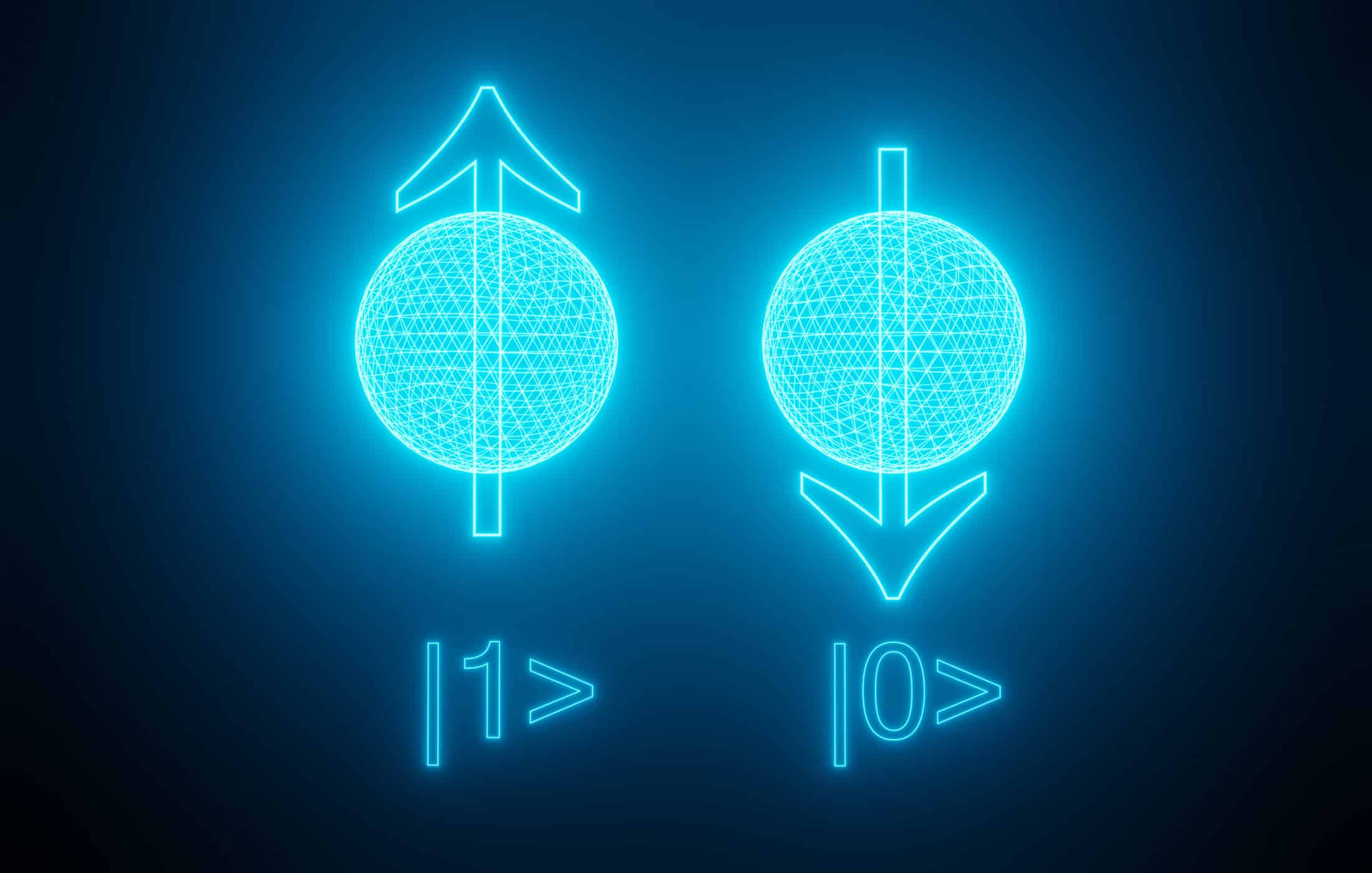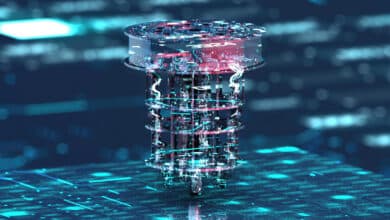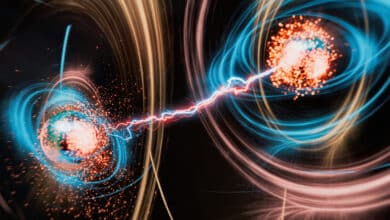What is Entanglement-as-a-Service (EaaS)?

Table of Contents
Introduction
Entanglement-as-a-Service (EaaS) refers to the on-demand delivery of quantum entanglement over a network, enabling distant users or devices to share entangled qubit pairs as a resource. In essence, a quantum network provider supplies entangled quantum states to clients as a service, analogous to how classical networks provide data connectivity . This report explores the foundations of EaaS, current research and implementations, its integration into telecommunications infrastructure, emerging commercial use cases, and the future outlook for this cutting-edge paradigm.
Technical Foundations
Quantum Entanglement and Quantum Networking Basics
Quantum entanglement is a phenomenon where two or more particles become correlated in such a way that their quantum states are interdependent, no matter the distance between them. Measuring one entangled particle instantly influences the state of its partner, a counter-intuitive effect that Einstein famously dubbed “spooky action at a distance.” These non-classical correlations have no equivalent in classical communication and form the bedrock of quantum information science.
In a quantum network, entanglement is the fundamental service that links distant nodes. Instead of merely sending bits, a quantum network distributes entangled qubits (often photons) between nodes. Once two nodes share an entangled pair (often called a Bell pair), they can perform quantum communication protocols. For example, by using entangled qubits and classical messages, one can achieve quantum teleportation – transferring a quantum state from one node to another without sending the physical particle itself. Teleportation doesn’t move matter, but it uses shared entanglement and a few classical bits to transmit the state of a qubit instantly across the network. This ability to transmit qubit states forms the basis of quantum communications and distributed quantum computing.
Achieving entanglement distribution over long distances is technically challenging due to loss and decoherence. Directly sending entangled photons through fiber or free space leads to signal loss (e.g. the Chinese Micius satellite experiment could only recover ~1 out of 6 million photons transmitted). Quantum repeaters are therefore crucial for EaaS. A quantum repeater is a device (or system of nodes) that extends the range of entanglement by segmenting the channel and using intermediate quantum memories to store qubits and perform entanglement swapping. In entanglement swapping, two entangled links can be joined: if node A is entangled with B, and B with C, a quantum operation at B can entangle A and C, even though A and C never interacted directly. By leapfrogging entanglement in this way, a chain of short entangled segments can produce end-to-end entanglement across long distances. This is analogous to how classical network switches or routers pass along packets, but in the quantum case the “payload” is an entangled state that must be carefully preserved. Crucially, unlike classical signals, quantum states cannot be amplified mid-transit without destroying the information. Quantum repeaters instead use storage (quantum memory) and error correction to boost range. Recent research has demonstrated repeater building blocks: for instance, a 2024 experiment in Boston showed that quantum memory nodes (silicon-vacancy centers in diamond) can catch and store photons, enabling entanglement to be distributed and stored across a 35 km fiber loop.
How EaaS Is Implemented
Entanglement-as-a-Service is implemented by creating a network that can generate, distribute, and manage entangled qubits between multiple endpoints on demand. In practical terms, this means an operator (such as a telecom carrier or specialized quantum network provider) deploys entanglement sources (like lasers that produce entangled photon pairs) and a series of quantum nodes (which may include quantum repeaters or trusted stations) across a region. Through a combination of quantum channels and accompanying classical control channels, the network can deliver entangled qubit pairs to any two (or more) client nodes that request a connection. Aliro, a quantum networking startup, describes EaaS as connecting users with entangled qubits across long distances using networks of quantum repeaters. The service involves a control plane coordinating both the quantum and classical aspects of the network: for example, scheduling entanglement generation, performing entanglement swapping at intermediate nodes, and signaling to end users that entangled pairs are ready. Because two communicating parties share an entangled state, they can then exploit quantum protocols (teleportation, superdense coding, or measurement-based key generation) over the entangled link. In summary, EaaS provides entangled qubits as a network utility – much like cloud computing provides computing power – enabling clients to build higher-level quantum applications on top of this entanglement resource.
It’s important to note that a full EaaS deployment requires integration of quantum hardware with classical networking. Every entanglement distribution is accompanied by classical messaging (to coordinate measurements, verify entanglement fidelity, etc.), so EaaS systems operate over hybrid quantum-classical networks. There are typically three types of channels involved in such a network: (1) the quantum channel carrying the entangled photons (qubits), (2) a real-time classical channel for time synchronization or instantaneous coordination (e.g. sending measurement bases or heralding signals), and (3) a non-real-time classical channel for general control, management, and orchestration traffic . The quantum channel often consists of standard telecom fiber (or free-space laser links) through which single photons are transmitted – one must avoid any device on this path that would disturb quantum states (no optical-electrical converters or amplifiers in line). Meanwhile, the classical channels can use regular internet infrastructure (TCP/IP over fiber or wireless) to carry protocols for entanglement requests, network management, and error correction information. In essence, implementing EaaS means overlaying a quantum entanglement distribution layer on top of (and tightly coordinated with) existing classical networking.
Current Research & Status of EaaS
Research into quantum networking and EaaS has accelerated rapidly in recent years, with breakthroughs in both academic experiments and industry-led prototypes. On the academic front, a landmark was the realization that entanglement can be distributed at continental scale: in 2017, a Chinese team led by Jian-Wei Pan used the Micius satellite to send entangled photon pairs to ground stations 1,203 km apart. This demonstrated the principle of space-based EaaS, although the photon loss was extremely high (due to atmospheric and detector inefficiencies) resulting in low data rates. Around the same time, the U.S. Department of Energy launched quantum network testbeds. By 2020, Chicago-area labs had entangled photons over a 52-mile (84 km) fiber loop and even demonstrated a 3-node network where entanglement was sustained in a quantum “memory” node along the way. In 2022, three independent groups in the U.S., Netherlands, and China each showed entanglement distribution in real-world environments (using city fiber networks and quantum memory devices), marking the transition from laboratory fiber coils to metropolitan-scale quantum networks. Notably, researchers at Delft (Netherlands) achieved a multi-node quantum network where two end nodes became entangled without ever directly interacting, using an intermediate node to swap entanglement – the first quantum network entangling three nodes separated by several kilometers, an early prototype of EaaS in action.
In 2024, a collaboration between Harvard University and AWS demonstrated one of the most advanced quantum network testbeds to date: a 35 km deployed fiber loop under Boston connecting two quantum memory nodes. This network could distribute and store entanglement for over a second, using cryogenic diamond-based quantum repeaters to preserve quantum states in transit. One key result of this experiment was showing that memory lifetimes of ~1 second are long enough to not be the limiting factor even for intercontinental distances (light can travel ~300,000 km in that time) . However, the team noted that to make such a network commercially viable, significant improvements in throughput (entangled pairs per second) and fidelity are needed – for instance, by multiplexing many entangled channels and refining the hardware for lower error rates . This underscores a general status update: fundamental feasibility of EaaS is being proven in the field, but scaling up to high rates and many nodes is the next challenge.
On the industry side, startups and tech companies are actively developing EaaS-enabling technologies. Aliro Quantum (a U.S. startup) has been working on a hardware-agnostic quantum network control plane to support entanglement distribution. In 2021, Aliro received contracts from the U.S. Air Force to advance “quantum entanglement-as-a-service” for secure communications. The company positions EaaS as “the key technology for the un-hackable secure networks of today and the quantum internet of tomorrow.” Their approach highlights that just as classical networks needed standardized protocols and management layers, quantum networks need a unifying software layer to allocate resources, manage entangled links, and interface with various quantum hardware. Another startup, Qubitekk, focuses on entanglement-based quantum key distribution (QKD) devices. Qubitekk has commercialized small entanglement sources and in 2020 helped demonstrate secure smart-grid communications in Chattanooga by delivering entangled photons between power substations for key exchange . Established firms are also in the game: ID Quantique (IDQ) has sold QKD systems for over a decade and is now developing next-gen entanglement-based networks with quantum memory and repeater technology . Their deployed solutions include a nationwide quantum-safe network in South Korea (with SK Telecom) using a mix of trusted nodes and moving toward quantum repeaters.
In summary, the current status of EaaS is transitional – moving from isolated lab demonstrations to early-stage network rollouts. Metropolitan testbeds (in Chicago, Boston, Hefei, Delft, etc.) are validating components like quantum repeaters and entanglement swapping under real-world conditions. A few commercial services are in pilot phases, mainly for quantum key distribution on fiber links (often with interim trusted nodes) and for research partnerships (e.g. AWS’s Center for Quantum Networking working with academia). Standardization efforts have also started: for instance, the Internet Engineering Task Force (IETF) has outlined architectural principles for a quantum internet, explicitly identifying entanglement distribution as the core service on which all applications will build. These developments signal that EaaS is evolving from a theoretical concept to an emerging technology, though wide-scale deployment will require further advances in hardware reliability and network integration.
Telecommunications & Infrastructure Integration
Telecom operators are particularly interested in EaaS because it represents both a solution to future security threats and an opportunity for new network services. One major driver is the impending advent of quantum computers that could break current encryption (the so-called “Q-Day” when algorithms like RSA and Diffie–Hellman become vulnerable). Quantum entanglement-based communication offers cryptographic protection that is fundamentally different from classical encryption – in theory, it can be unconditionally secure based on the laws of physics. Telcos, who operate critical communication infrastructure, see quantum networks as a way to future-proof data security for governments, businesses, and consumers. For example, quantum key distribution (QKD) allows two distant parties to generate shared secret keys with security guaranteed by quantum mechanics. Some telecom companies (BT, Verizon, SK Telecom, etc.) have already trialed QKD links in their fiber networks to provide ultra-secure connectivity (e.g. for bank data centers or 5G backhaul encryption). Entanglement-based networks take this further: by using entangled photons and quantum repeaters (often termed Quantum Secure Communication when replacing classical QKD) they remove the need for trusted intermediate nodes and can support multiple applications on the same infrastructure. In other words, instead of building one-off QKD links, telcos could deploy a general-purpose quantum entanglement network that any customer could tap into for various quantum services.
From an infrastructure standpoint, EaaS leverages much of the existing fiber-optic backbone that telcos already own. Standard telecom fiber can carry entangled qubits, and importantly it can do so simultaneously with classical data channels by using different wavelengths (a technique known as Wavelength Division Multiplexing). For instance, a fiber strand that currently carries internet traffic on C-band channels could dedicate an O-band channel to quantum entanglement photons . This ability to multiplex reduces the need to lay new fiber solely for quantum links, which is attractive for operators looking to minimize cost. However, integrating quantum signals on existing fibers comes with challenges: the noise from intense classical signals can overwhelm single-photon detectors. Thus, telcos must carefully engineer the power levels and filtering – often the entangled photon channel is isolated in a band of the spectrum and kept relatively low-loss and low-noise, potentially using dark fiber or fiber with only passive optical components between the quantum end-points. Many current quantum network trials use dedicated fiber segments initially, but as technology advances, co-propagation of quantum and classical channels is expected to become more feasible with improved photonic filtering and superconducting nanowire single-photon detectors that are resilient to background noise.
Another aspect of integration is the network architecture. Telecom networks are layered (physical fiber, data link, network routing, etc.), and similarly quantum networks will have layers. Telcos are contributing to defining these: for example, the physical layer might consist of entanglement sources and detectors at central offices, the data link layer involves establishing entangled pairs over one hop, and higher layers handle end-to-end entanglement routing and management. Projects are underway to incorporate quantum channels into existing telecom hubs and switches. A practical consideration is that all active switching for quantum signals must be avoided or done quantum-mechanically. This means telcos might adopt all-photonic switching or use trusted node hand-offs until true quantum repeaters are deployed. Despite these hurdles, the impact on global networking could be profound: a fully developed EaaS integrated into telecom networks would essentially create a parallel quantum internet overlaid on the classical internet. This quantum internet would coexist with classical networks (not replace them) , augmenting capabilities by enabling things like provably secure communication channels, quantum-enhanced clock synchronization across networks, and cloud-based quantum computing that spans multiple data centers.
Telcos also foresee that offering EaaS could differentiate their services and open new revenue streams. Just as many operators now sell cloud and edge computing services alongside connectivity, in the future a telco could sell quantum networking as a service to its clients. For example, a bank might pay for a quantum-entangled link between its headquarters and data center to guarantee security for transactions, or a research consortium might lease an entangled channel between two quantum computer facilities in different cities. Because EaaS networks will be general-purpose, a single quantum backbone could support many such use cases simultaneously – similar to how the internet carries many applications on one infrastructure . This prospect has spurred collaborations between telecom giants and quantum tech firms; we see national telecoms in Europe and Asia partnering on quantum communication testbeds, and standards groups (ETSI, ITU, IETF) working on interoperability standards so that eventually quantum entanglement services might interconnect across providers globally. In summary, the telecom industry views EaaS both as a defensive necessity (to secure networks against quantum threats) and an innovation opportunity (to offer cutting-edge services), and is actively investing in integrating quantum entanglement distribution into the world’s communications infrastructure.
Physical integration of quantum and classical channels: In emerging quantum networks, separate fibers or wavelengths carry the quantum channel (entangled qubits) and classical control channels. Standard telecom fiber can be used for entanglement distribution, often putting quantum signals in a different band (e.g. O-band) from classical data to minimize interference . As shown above, a quantum network device interfaces with both quantum and classical links. No optical amplifiers or routers can sit in the quantum channel path (only passive optics), while classical Internet equipment handles the coordination and any user data that accompanies the quantum transmissions.
Commercialization and Use Cases
As quantum networking technology matures, companies are beginning to explore business models for EaaS and identify practical applications. At its core, EaaS turns entanglement – traditionally a delicate lab phenomenon – into a commercial resource that can be requested and used on-demand. Several emerging use cases demonstrate the value of this capability:
Quantum Key Distribution (QKD) and Quantum Secure Communications: The most immediate application is secure communication. Entanglement-based QKD protocols (such as Ekert’s E91 protocol) allow two parties to generate identical encryption keys by performing measurements on shared entangled qubits . Because any eavesdropping attempt would disturb the quantum correlations, QKD provides unprecedented security for key exchange. Telecom operators and specialized providers are looking to offer “quantum-secured links” as a managed service, where clients get continuously updated encryption keys guaranteed by physics. In fact, Key-as-a-Service (KaaS) has been proposed, where a quantum network delivers fresh secret keys to users on demand . Going further, Quantum Secure Communication (QSC) uses entanglement and quantum repeaters to send confidential data without even transmitting the raw data bits through a vulnerable channel (the data is encoded into quantum states and decoded only at the destination) . This could appeal to banks, governments, and healthcare providers for ultra-sensitive data transmission.
Distributed Quantum Computing: EaaS can connect quantum processors in different locations, allowing them to function as a larger virtual quantum computer. Entangled links enable techniques like remote operations (teleported quantum gates) and sharing of quantum states across nodes . Companies envision quantum data centers where multiple smaller quantum computers are entangled to tackle problems beyond the capacity of a single device. For example, a cloud provider might use EaaS to entangle qubits between two of its quantum machines and perform a distributed algorithm (essentially parallelizing a quantum workload). This can also provide redundancy – if one machine has a few qubits free, they could be entangled with another machine’s qubits to jointly run an algorithm. Although fully realized distributed quantum computing is still experimental, early demonstrations (like the Harvard/AWS network with two nodes performing entanglement and simple processing) hint at the possibilities . In the future, a quantum cloud service might let users tap into a pool of entangled quantum computers much as today’s cloud offers pooled classical computing power.
Distributed Sensing and Metrology: Entangled networks can improve sensing, timing, and imaging. In a quantum sensor network, spatially separated sensors (for gravity, magnetism, etc.) share entanglement to surpass classical limits of precision. One cited idea is an earth-wide entangled array of sensors acting as a single telescope or detector, potentially detecting faint phenomena (like dark matter signals or gravitational waves) with enhanced sensitivity . Similarly, entanglement can be used for high-precision clock synchronization across large distances (better than GPS timing), which is crucial in navigation and telecommunications. While these use cases are more niche and further out, companies in aerospace and defense are monitoring them – an entangled GPS or an entangled radar system could offer strategic advantages in accuracy and security.
Cloud Quantum Random Number Generation: Entangled qubits can be used to generate truly random numbers for cryptographic purposes. A service provider could use EaaS to supply certified quantum random numbers to clients (an extension of today’s cloud-based RNG services). Because measuring one of an entangled pair yields inherently random outcomes (with the twin producing a perfectly correlated random outcome), such a system can generate shared randomness for multiple parties with guaranteed unpredictability.
Secure Multi-Party Computation and Networking: Beyond two-party communications, multipartite entangled states (like GHZ states involving 3 or more nodes) enable applications such as conference key agreement (secure group chats where a single quantum process establishes a key shared by all parties) and secret sharing schemes that are information-theoretically secure. A commercial EaaS offering might provide a virtual “quantum meeting room” service: a group of nodes receives an n-partite entangled state that they then measure to obtain a common secret key for encrypted conferencing.
To deliver these applications, business models for EaaS are taking shape. We can draw parallels to classical cloud and telecom services. One model is a subscription or utility model: clients pay for a certain rate of entangled bits (often measured in Bell pairs per second) between locations, similar to paying for bandwidth. For instance, a data center might subscribe to an EaaS service to continuously obtain 1,000 Bell pairs per second between its two sites, which it then uses for an ongoing QKD link or distributed computing tasks. Another model is on-demand provisioning: a user requests an entangled link for a session (just as one might set up a VPN or rent cloud compute hours) and the network sets up the quantum channel for the duration needed. We see early signs of these models: telecom carriers in China, Europe, and the U.S. have begun including quantum key services in their product catalogs for enterprise clients, often bundling the quantum service with classical connectivity for a premium.
Startups like Aliro aim to be intermediaries, providing the software platform to orchestrate entanglement services across whatever hardware exists . This hints at a possible platform model: one company manages the quantum network software and partners with infrastructure owners (telcos, satellite operators) who supply the physical links. In all cases, partnerships between quantum tech firms and telecom/cloud providers are crucial, since EaaS straddles both domains. For example, AWS’s interest in quantum networking suggests a future where a cloud provider might integrate EaaS into its cloud offerings – imagine an AWS or Azure service where your quantum computing resources in different regions come pre-linked by entanglement for cross-talk.
Despite the excitement, significant challenges remain in deploying EaaS commercially. One major challenge is scaling the hardware: generating and distributing entanglement at high rates over long distance is hard. Present quantum networks can achieve maybe thousands of entangled pairs per second under ideal conditions , whereas practical applications (like streaming one-time-pad keys for high-bandwidth encryption) could demand orders of magnitude more. Scaling up implies improvements in sources (brighter entangled photon sources, possibly integrated on photonic chips) and detectors (high-efficiency, fast single-photon detectors). Another challenge is maintaining entanglement fidelity over a network with many components. The more nodes or hops, the greater the chance of decoherence or accidental measurement collapsing the quantum state. Quantum error correction for entanglement (sometimes using techniques like entanglement distillation) will be needed to provide service reliability akin to classical network QoS. Additionally, quantum memories and repeaters are still early in development; the first-generation repeaters work but with limitations (e.g. needing ultra-cold temperatures and specialized materials) . Engineering these devices to be deployment-friendly (rack-mountable, stable, and eventually cost-effective) is a work in progress.
There are also operational challenges. Running a quantum network will require new expertise – telecom engineers will need training in quantum physics concepts, and new tools will be needed for monitoring quantum link health (you can’t simply “ping” a quantum channel without disturbing it). Early commercial EaaS offerings will likely be confined to niche uses (e.g. government/military communications, inter-bank connections) where the absolute security justifies the complexity and cost. However, as the technology matures, automation and scale will drive costs down. Just as the internet was once a research curiosity and is now ubiquitous, stakeholders believe quantum networks will eventually become an invisible yet fundamental part of our communications ecosystem, with EaaS being offered much like cloud storage or VPN services today.
Future Outlook for EaaS
The coming decade is poised to bring significant advancements that will shape Entanglement-as-a-Service into a practical reality. Technical progress is expected on multiple fronts. Quantum repeaters and memory devices are rapidly improving; researchers anticipate that by the late 2020s, memory-based quantum repeaters will be robust enough for deployment, removing the need for trusted nodes and enabling truly end-to-end quantum entanglement distribution across hundreds or thousands of kilometers . This will likely start with regional quantum networks (connecting cities in a country) and then expand to international links. Satellite-based EaaS will complement fiber networks to achieve global coverage – e.g. low-earth-orbit satellites distributing entanglement to ground stations could link distant continents, an approach already proven viable by China’s Micius satellite and being pursued by the European Space Agency’s planned quantum communications satellites. As entanglement generation rates climb with better hardware, we expect the “bandwidth” of entanglement services to increase to millions of entangled pairs per second , which will make high-data-rate quantum-secure communications and multi-node quantum computing applications much more feasible.
Standards and interoperability will solidify as well. Organizations like the IETF, ETSI, and national initiatives are actively developing the protocols for quantum networks. An early IETF RFC has set guiding principles (with entanglement as the core service) , and we can expect concrete protocol standards for tasks like entanglement swapping, quantum routing, and resource reservation. These standards will ensure that different quantum network equipment and even different network operators can interconnect – much as today one internet provider’s network talks to another’s seamlessly. Governments and industry consortia are likely to establish testbeds as interoperability proving grounds (much like the ARPANET was for the classical internet). The U.S. DOE, for instance, laid out a blueprint in 2020 for a nationwide quantum internet, envisioning a prototype by 2030 that connects national labs and universities as a backbone . The EU’s Quantum Flagship program similarly is funding the Quantum Internet Alliance to build a multi-node network demonstrator and push technologies like quantum repeaters toward readiness. Such efforts indicate a coordinated push to move EaaS from experimental to operational.
Regulatory and policy considerations will also come into play. Because EaaS deals with communication security, national governments are keenly interested. We may see regulations to ensure quantum communication services meet certain security standards (for example, certification of quantum devices, or requirements for critical infrastructure operators to use quantum-safe communications by a certain date). Export controls might be considered for advanced EaaS hardware (similar to how encryption tech was regulated), as quantum networking capability could be seen as strategic technology. Additionally, the advent of essentially unhackable communication raises policy questions: intelligence and law enforcement agencies may worry about “going dark” if criminals use quantum-encrypted channels. This could lead to debates similar to those around strong encryption today, possibly influencing how EaaS services are offered (e.g. whether networks require some form of quantum network oversight or audit trail, though the very point of EaaS is that eavesdropping is nearly impossible). On the positive side, governments are heavily investing in this field – not just for security but for economic opportunity – and will likely continue to fund R&D and startups, as well as build a friendly regulatory environment for pilots (sandboxes for quantum communications experiments, spectrum allocations for quantum laser links, etc.).
When it comes to market and investment trends, the trajectory is upward. Venture capital and corporate investment in quantum communications startups have been growing, albeit not as feverishly as in quantum computing. As of mid-decade, companies like Aliro, Qunnect, Qubitekk, ID Quantique, and others have secured funding from defense agencies and tech investors, recognizing that quantum networking is a critical piece of the quantum technology puzzle. Tech giants are also in the mix: Amazon’s AWS launched a dedicated Center for Quantum Networking in 2022 to develop hardware and applications, Google has explored connecting superconducting qubit processors via photons, and Toshiba has a division commercializing QKD hardware for telecom operators. We can expect strategic partnerships – e.g. telecom companies partnering with quantum tech firms – to multiply once early products (like quantum repeaters or metro-area quantum network gear) hit the market. In the next 5 years, we’ll likely see the first commercial EaaS offerings emerge, perhaps targeted at niche needs: for example, a secured quantum link product for datacenter interconnects, or a quantum network service connecting research labs and universities. These initial services will pave the way for broader adoption as costs decrease.
In terms of vision, experts often compare the state of quantum networking now to the state of classical networking in the 1970s: small experimental networks demonstrating basic functionality, with enormous potential but applications still being discovered . Just as nobody in 1970 could predict the full range of internet applications today, we likely haven’t imagined all the uses of EaaS. Hints of future applications – like global quantum sensor arrays or new cryptographic protocols – are already on the horizon, but new ideas will surely emerge once the infrastructure is in place. The long-term outlook for EaaS is that it will become an integral service underlying our information society. A fully realized quantum internet would allow any two points on Earth to share entanglement on demand, enabling instantaneously coordinated quantum operations and communications with absolute security. Achieving that vision will take sustained innovation in science and engineering. The next decade will be a formative period, converting today’s prototypes into the backbone of tomorrow’s quantum-enhanced world.
In conclusion, Entanglement-as-a-Service is transitioning from a fascinating concept to a nascent reality. Its technical foundations are solidly rooted in quantum physics, its current development is accelerating through global research efforts, and its promise has caught the attention of the telecommunications industry and beyond. While challenges remain in scaling and integration, the trajectory is clear: EaaS and quantum networks will likely be as transformative in the 21st century as the internet was in the 20th, opening new frontiers in secure communication, computing, and sensing. Industry stakeholders and technical professionals would do well to follow these developments closely, as quantum entanglement delivered as a service could become a cornerstone of the next-generation digital infrastructure.



